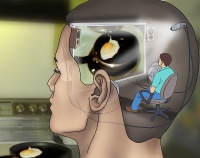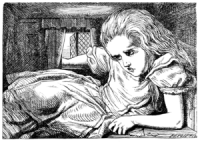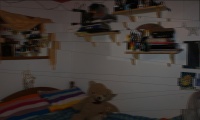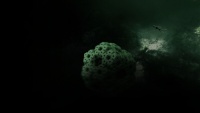Dissociatives: Difference between revisions
m (Reverted edits by Dumbdumb123 (talk) to last revision by Sleep) |
Lightning po (talk | contribs) m (→Harm Reduction: small spelling mistakes) |
||
| Line 118: | Line 118: | ||
*Driving or operating machinery under the influence of dissociatives is strongly discouraged. Your spatial awareness is extremely limited, even when mildly intoxicated. | *Driving or operating machinery under the influence of dissociatives is strongly discouraged. Your spatial awareness is extremely limited, even when mildly intoxicated. | ||
*On higher | *On higher doses coordination is impared to the point that any movement should be as limited as possible. A safe environment without hazards is recommended (such as a bed). Most of the damage imparted by dissociatives are through users hurting themselves while attempting to move around while impaired. | ||
*Nausea can happen on many dissociatives, usually directly after dosing - usually only if there are stomach contents. It is best to not eat for 3-4 hours before dosing. | *Nausea can happen on many dissociatives, usually directly after dosing - usually only if there are stomach contents. It is best to not eat for 3-4 hours before dosing. | ||
*Dissociatives may be neurotoxic.<ref>http://dx.doi.org/10.1126%2Fscience.2660263</ref> Moderation is advised. | *Dissociatives may be neurotoxic.<ref>http://dx.doi.org/10.1126%2Fscience.2660263</ref> Moderation is advised. | ||
Revision as of 22:28, 26 May 2020

Dissociatives are a class of hallucinogen which reduce or block signals to the conscious mind from other parts of the brain. In comparison to psychedelics and deliriants, they are a very new class of hallucinogen, with the first classical dissociative being synthesized in 1926 (PCP). They offer a trip that is characterised by dissociation and bizarre feelings of detachment from reality, with anaesthetic-like effects and dream-like states.
This guide is in reference to all of the classical Dissociatives, or more specifically, Ketamine, MXE, DXM, PCP and 3-MeO-PCP. This list excludes Nitrous Oxide, which feels completely atypical in comparison.
It’s worth noting that Dissociatives can be addictive and bad for your health with regular long-term usage, so you’ll need to do some independent research before trying these. Although these hallucinations are completely different to anything found with psychedelics, they should not be underestimated, and allow you to go equally as "deep" in a completely different mental landscape. However, they are not nearly as powerful when it comes to introspection and resolving personal problems.
All of the classical Dissociatives are pharmacologically categorised as NMDA receptor antagonists, which are a class of anaesthetics that work to antagonise, or inhibit the action of, the N-methyl d-aspartate receptor (NMDAR). The NMDA receptor is a receptor that allows for the transfer of electrical signals between neurones in the brain and in the spinal column. These receptors are located at the end of dendrites on a neurone cell. The dendrites send messages to other neurones through these, but when a drug that blocks the NMDA activity is taken, they are partially or entirely blocked, decreasing the brain's ability to transfer information across itself. Disconnecting the neurones and causing feelings of extreme dissociation or detachment, leading to hallucinatory states. Causing states of moderate to extreme dissociation in the user as the subconscious brain begins to fill in these sensory gaps with entirely imagined hallucinations and dreamlike states.
Common Dissociatives
Effects
Dissociation and detachment

Feelings of detachment are the most noticeable component of a dissociative trip. Which is entirely triggered by the blocking of NMDA receptors.
At lower states of dissociation, this essentially feels like an obvious but still difficult to pinpoint feeling of detachment from the external environment and body. The greatest analogy to depict this is that if we look at the world through a window during our day to day lives when a person becomes dissociated they are standing increasingly further back from this window proportionally to the dosage consumed. Creating a feeling of being mentally withdrawn from the environment, allowing people to look at their lives from an almost third-person perspective and analyse it without bias, surprisingly resulting in an enjoyable state of deep introspection and a profound drunkenness. These states are often described by people as:

- Feeling generally separate from the external world.
- Feeling physically and mentally autonomous.
- Feeling as though life is being watched through a screen.
- Feeling as though life is a film or a dream.
- Feeling as though you are physically further from the external world.
- Feeling as though you are looking through somebody else’s eyes.
States of dissociation and detachment increase proportionally to dosage until they become completely detached from the external environment and eventually their own bodies causing them to slip into the famous dissociative hole.
A process which can be broken down into three distinct levels of increasing intensity.
1. Partial detachment
Feelings of surrealness and general detachment from the external environment. As described in detail above. detachment from the environment.
As the detachment increases the environment becomes physically further away in distance and increasingly disconnected from a person's sensory perception. Blurred vision sets in while anaesthetic like effects and tactile numbness begin to take place. At this point, motor control and balance become moderately to completely suppressed in a way that is proportional to dosage. In terms of sound, the hearing also seems to become muffled and distant.
2. Detachment from body
Complete disconnection from the body. It is here where the tripper finds themselves out of their body has slipped into a what can only be described as a hallucinatory hole or an empty void.
3. Detachment from mind and sense of self
The final level of dissociation and detachment is a complete disconnection from a person's mind and sense of self-resulting in ego death. Giving the profound experience that there is no longer an “I” experiencing the intensity of the trip anymore, there is just the trip as it is and by itself.
In terms of the thought patterns and general mental processes, dissociative ego death is very similar to its psychedelic equivalent in a number of ways. Characterised by an extreme loss or failure of a person’s short-term memory. This means that a person who is experiencing ego death cannot hold onto the memory of where they are and what they are doing for more than a second or two, instantly forgetting everything as soon as it happens to them. Long-term memory, however, seems to remain mostly intact, with people usually capable of remembering things like who they are and what they are unless they are experiencing ego death at a, particularly high level.
Double vision

As a person begins to become disconnected and detached from their external environment. The visual field not only becomes blurred and indistinct but completely doubled onto itself as well. This feels as if you are seeing out of both of your eyes at once with the two images no longer being spliced and merged together into a unified whole. Forcing people to close one of their eyes if they want to perform any task which requires fine vision or reading.
Perspective distortions

Another very common mental component of a classic dissociative trip is one of a profound shift in perspective; this generally consists of drastic changes in the size and distance attributed either to a person’s body or their external environment.
Feelings of suddenly having an impossibly giant or tiny body are very common and can be quite an incredible experience. This feeling is already known by the scientific literature as “Alice in Wonderland Syndrome”. It is known as a temporary condition often associated with migraines, brain tumours, and of course the use of psychoactive drugs. With dissociatives at least it can also be more specifically attributed to the room around you or certain body parts. For example feelings of having a huge head or tiny limbs are quite common. This specific mental component has limitless potential in terms of size and the feeling of being simultaneously huge and tiny or having a body that feels larger than the entire universe is not unheard of.
Perspective distortions can also affect distance, making specific objects or the entire external environment seem physically closer or further away. Another common manifestation of this effect changes in noise volume, making sounds seem extremely quiet or extremely loud.
Scenery slicing

Scenery slicing is a fairly uncommon visual but appears across multiple people and regularly enough to make it worth mentioning. This effect usually happens spontaneously with no obvious trigger and makes the external environment appear as if it has been cut remarkably cleanly into separate slices with a razor blade Which then slides across each other in separate directions causing the visual field to split apart into sections.
Closed eye visuals

Visuals are an effect triggered by Dissociatives that can be described as the sensation of a person’s field of closed-eye vision being partially or completely encompassed by shifting geometric patterns, shapes, structures and colour. Whilst LSD and Mushrooms merely display visuals on a veil in front of your visual field with no sense of particular size attributed them. Dissociatives take you directly into the centre of them as if they are surrounding you. They also have a sense of physical size attributed to them.
Dissociative visuals are more simplistic and less intricate than psychedelic visuals. They tend to be darker and slower in terms of how fast they change, only displaying themselves when the tripper has their eyes closed. Simply put, the visuals are more solid and realistic than psychedelic visuals with an actual sense of physical size and 3-Dimensional depth but never quite as detailed or complex.
Spaces and holes
The spaces and holes encountered on Dissociatives are something that is experienced once the detachment has reached level 3. When you have finally become completely disconnected from your physical body. Causing you to undergo an out of body experience and be pulled into a place that feels as if it is outside of reality.
A place that is commonly referenced to by the dissociative community as a hole. With drug-specific manifestations of this state being known as “the K-hole” for Ketamine and the “M-hole” for MXE. Commonly described as a complete loss of bodily awareness and sensations of floating or falling through a dark and infinite void over great physical distances. Often done on what feels like some sort of invisible rail. A feeling that is interpreted by many people as flying through space or the night sky. With many trippers stating that they feel as though their perceptions are located so deep inside the mind that the real world seems so distant that it might as well not exist.
In terms of its appearance, a typical dissociative hole is usually completely dark with occasional clouds of slow-moving amorphous colour clouds in the background. At their lowest level they are completely empty, but as dosage is increased they are accompanied by and filled with a wide variety of elaborate and complex structures which are described in detail below.
Hallucinatory structures

Dissociative induced hallucinatory structures are the only feature found within what would otherwise be completely empty spaces and holes. They can generally be described as 3-Dimensional and monolithic shapes or structures of infinite variety and size that float above, below or in front of you as they gradually zoom, rotate or pan into focus and become unveiled before your eyes at a slow pace. These structures can take any static comprehensible shape possible but can commonly be experienced as vast and giant pillars, columns, blocks, teardrops, wheels and pyramids. Often fractal in nature and capable of being manifested in any variety of colours but usually following darker themes and tones. In terms of the materials that they appear to be comprised of and the complexity of detail in which they are perceived in, dissociative structures can be broken into 4 basic levels.
1. 2-Dimensional Structures
The most basic level of structural complexity confines it’s geometry to strictly 2-Dimensional shapes. These shapes are usually very flat and dark in their colour and often “felt” instead of seen in a way that cannot be described adequately to the uninitiated. In terms of their size, these structures take up the entirety of a person's visual field but do not appear to have any particular size attributed to them.
2. Partially defined 3-Dimensional Structures
Above this, the structures become better defined and 3-Dimensional in shape with basic detail in their lighting and shadow. Appearing to be made of semi-transparent condensed colour or solidified shimmering visuals that are seen as ill-defined, soft and out of focus around their edges. In terms of size, these structures appear to be extremely large, stretching out across hundreds and hundreds of metres.
3. Fully defined 3-Dimensional Structures
Once hallucinatory structures reach their third level of complexity they become fully defined in their shape, edges, lighting, shadow and detail. Often appearing to be made of solid and dense realistic materials such as stone and metal. They are capable of being thousands of miles across themselves and extremely complex in form.
4. Self-transforming mechanistic structural universes

As dosage increases, the detail continues to complexity proportionally until the sensation of seeing the entire universe condensed into an infinitely vast and intricate self-transforming machine structure becomes present. Accompanied by the sudden realization that you are the structure that you are staring down upon and that the structure is also you. In terms of its appearance, this state is extremely hard to describe. The structure can take any form but usually appears to be consistently shaped machine-like structures or clouds that are infinite in size and felt at every point of detail across themselves. This is immediately interpreted through some sort of innate instinct as “the universe” or at least, “everything” by everybody who undergoes the experience.
Structures typically last anywhere from 30 seconds to several minutes before the person slips back into reality or into the presence of another structure. There are three different methods through which these hallucinatory structures are shifted between.
- Structural Transformations - structures can switch between each other by morphing around you in a static, comprehensible way. Something that usually unfolds in front of you in a rather slow, step by step morphing process.
- Structural Panning - structures can switch between each other by remaining completely static in their shape but simply panning out of view until they are no longer within your field of vision. It’s from here that another structure usually comes into view from behind your physical body within a few seconds to a couple of minutes. Allowing the cycle of continuous spontaneous structures to go on undisturbed.
- Travelling over great distances - The third method of transitioning is experienced when the structures appear to be stuck in place whilst you are floating silently between them over what feels like a huge and physical distance. This is often done on an invisible rail through the vast and infinite dissociative hole. A feeling that is interpreted by many people as flying through space or the night sky.
Hallucinatory states
Hallucinations and scenarios are only possible during very high dose trips and an intensely realistic component of the Dissociative experience. They could be anything but generally fall under common archetypes such as contact with autonomous entities, imagined landscapes, alternate dimensions, replayed memories and situations that seem so unlike anything previously experienced that they are in all probability, untranslatable into English. Starting out by following a feeling of detachment from the hallucination itself, for example watching autonomous people and entities going about their daily business oblivious to your existence, playing out as if it were a film. At higher doses of hallucinatory states they become increasingly involved, accessing distant memories from your past is also completely possible. Replayed memories can feel like weeks and weeks of real-time hallucinations and are perfect in every detail.
In comparison to psychedelics, they are more solid and not made of a closed eye visual based material. The solidity and detachment from these scenarios are what separates them in my opinion from any entity contact or hallucinations experienced on drugs such as Mushrooms or LSD.
Harm Reduction
- Driving or operating machinery under the influence of dissociatives is strongly discouraged. Your spatial awareness is extremely limited, even when mildly intoxicated.
- On higher doses coordination is impared to the point that any movement should be as limited as possible. A safe environment without hazards is recommended (such as a bed). Most of the damage imparted by dissociatives are through users hurting themselves while attempting to move around while impaired.
- Nausea can happen on many dissociatives, usually directly after dosing - usually only if there are stomach contents. It is best to not eat for 3-4 hours before dosing.
- Dissociatives may be neurotoxic.[1] Moderation is advised.
- Some dissociatives (such as ketamine) are known to have negative impacts on bladder health.[2], and it is suspected in others.
- If using a new substance having a sober person available may limit the fallout from unexpected effects.
- Doctors usually prescribe Ativan (Lorazepam/Benzodiazepine) and Haldol (anti-psychotic) to treat overdoses.
- As always, contact emergency professionals if you think you are a danger to yourself or others.
- Excessive use or overdose of dissociatives has been known to cause muscle breakdown (or rhabdomyolysis), which is a potentially fatal condition.
Interactions
It is generally unwise to mix CNS depressants, such as benzodiazepines or alcohol, as it increases the risk of an overdose through respiratory depression. Certain dissociatives also carry particular constraints in terms of interactions. See the Drug combinations chart for more information.
Research Chemicals
The dangers of research chemical dissociatives inherit many of the potential dangers of the more traditional dissociatives including overdose mania, muscle degradation etc and as with most well-established dissociatives, most of the new RCs carry a heavy risk of addiction. However, due to the new and unresearched nature of these drugs, the thresholds at which these negative effects occur is relatively unknown. MXE was created with the express intent of reducing the risk of urinary tract damage through higher potency, users with a high tolerance to the drug will take large amounts of material to experience effects, and there is no information about how it differs from other dissociatives with respect to such damage.
As with some more well-established dissociatives, there is often a wide range of isomer configurations which lead to inconsistencies in effects from one batch to another.
It is fairly common practice for vendors to misrepresent their product in various ways. There have been batches of RC dissos released which have been found to contain chemicals left-over from the manufacturer. There have also been many anecdotes reporting incidents of batches being sold with other active cuts. Since these drugs are all very new there have been very few actual laboratory analysis reports on the exact content of various RC dissos, and as such, there is a fair bit of speculation and misinformation circulating about all RCs. Furthermore, vendors and manufacturers have been known to make exaggerated claims that have never been actually proven (for example, the theory that MXE will be less physically destructive than its cousin Ketamine originated from one of the first vendors to carry the product)
Consider the case of Methoxyphenidine, which was named as such and abbreviated as 'MXP' specifically to be marketed as an MXE replacement, where in reality MXP is closer to PCP than it is to MXE in chemical structure and effects.
See the Research Chemicals page for more information.
Links
http://en.wikipedia.org/wiki/Dissociative